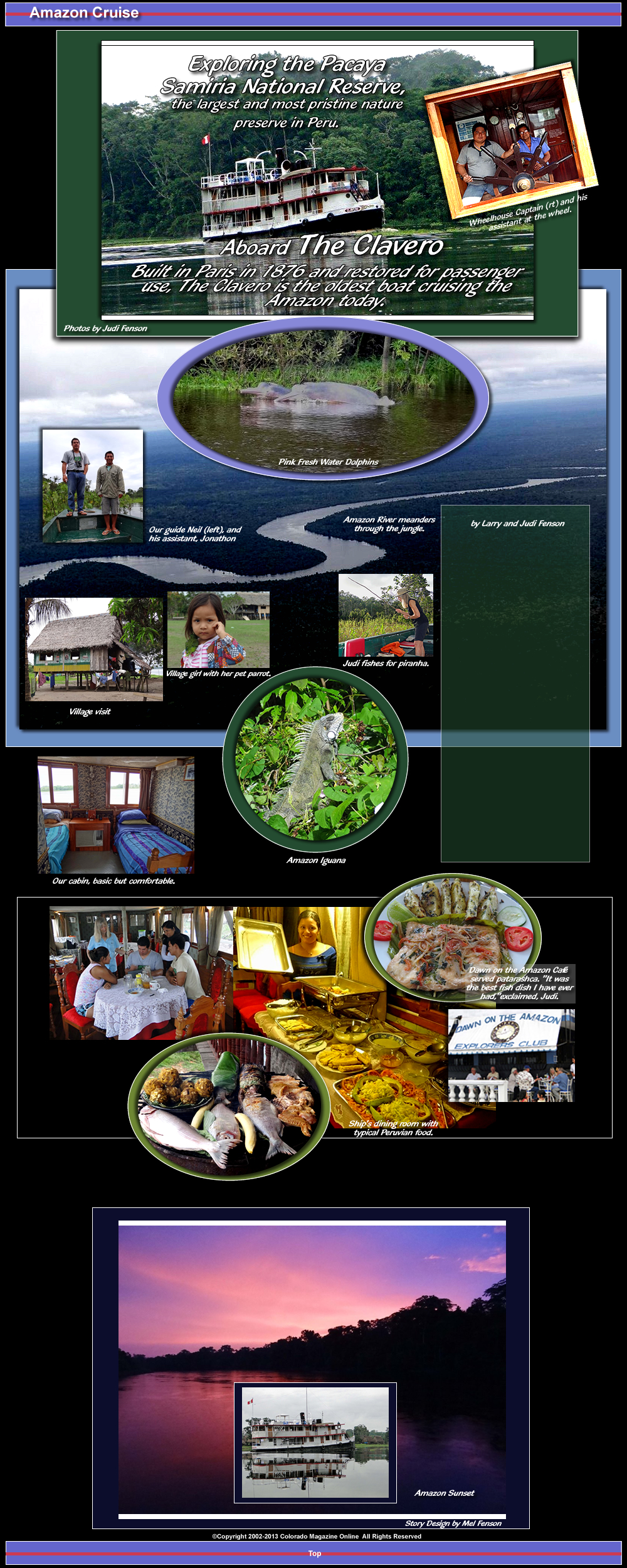

Our
adventure began in Iquitos, Peru, a large, bustling town of half a million.
Positioned directly on the mighty Amazon River and surrounded by vast stretches
of the Amazon rain forest, Iquitos is reachable only by river and by air,
giving it the feel of a frontier town. Iquitos has a colorful history as a
main export center during the rubber boom days that began in the 1880s.
Ornate mansions were built by rubber barons whose wealth and extravagances
paralleled those who struck it rich in the Alaska gold rush. A legacy of those
days may clearly be seen in the architecture of Iquitos today. One impressive
building, amazingly, was designed by Gustave Eiffel (of Eiffel Tower fame),
constructed in sections in Belgium and assembled in Iquitos in 1890.
We felt transported back to that time by staying in the immaculate Casa Morey
Hotel, a restored mansion with airy, high-ceilinged rooms overlooking the
Amazon River. The hotel’s grand chandeliers, antique tiles and period
furnishings in the lobby, the ornate dining room and the elegant library perfectly
reflected that golden period and served as an appropriate prelude for our
river trip on a ship of the same vintage.
Built in Paris in 1878, the Clavero is the oldest boat still plying the Amazon.
For some years the Clavero was owned by the Peruvian Navy and was actually
involved in battles with Ecuador. It was completely refurbished about 5 years
ago and is now used by scientists and educators and for ecotours. It exudes
character from the classic wooden steering wheel to the collection of historic
books in the dining room.
The Clavero can accommodate 12 passengers in its six air-conditioned cabins.
Luckily, our party of four had the boat all to ourselves along with the captain,
a crew of six, our guide Neil and his assistant Jonathan. The cook served
delicious typical Peruvian dishes and, at 3:00 pm daily, we were pampered
with tea and cake.
The Voyage
Our destination was Pacaya Samiria National Reserve, the largest and most
pristine nature preserve in Peru. The Clavero along with its sister ship,
the Ayapuya, are the only ships allowed into the reserve. Other ships like
the Delphin and the Aqua must stop outside the reserve and transport their
passengers for day excursions into the reserve in motor boats.
It takes about a day to reach the reserve. In sailing to and from the entrance, passengers have an opportunity to observe the timeless life along the shore as the ship passes small villages. On the larger waterways, such as the Marañon River, there is a continual procession of fishing vessels, barges, long distance passenger ferries and an occasional ship with tourists (none with capacities of more than about 50 passengers).
Once
the reserve is reached, the voyage shifts from interesting to stunning. The
rivers within the reserve have a black, mirror-like sheen that perfectly reflects
the images of the trees along the bank and any boats in the river. The effect
is mesmerizing. Over the next four days, we explored the reserve in skiffs
to penetrate more deeply into areas where the Clavero could not navigate.
The colorful bird life everywhere in the Amazon is exceptional. We did some
early morning bird excursions and some after dark to experience the starlit
sky and the amazing symphony of jungle insects, frogs and birds. We fished
for piranha and, at night, searched for caiman and other nocturnal creatures.
We also spotted various kinds of monkeys, pink river dolphins, frogs, iguanas
and sloths. And we had the opportunity to visit several native villages and
do some jungle walks.
All and all, Pacaya Samiria, in our view, represents the best the Amazon has
to offer. And so to experience it in what amounted to our own private river
boat with a very accommodating crew and two great guides was a special experience.
Our
trip was arranged by:
www.greentracks.com
 |
|